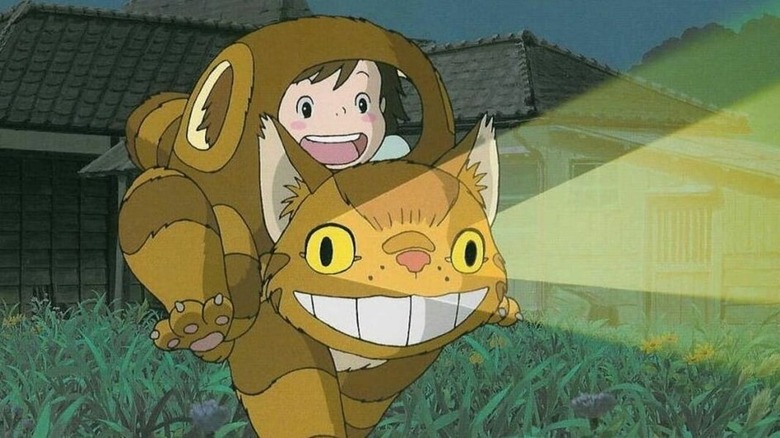
Studio Ghibli
"My Neighbor Totoro" is undoubtedly one of the best Studio Ghibli movies. It gave the studio its mascot, and is a perfect movie that's both sweet and cuddly, like its titular forest spirit, but also carries layers of darkness and nuance. This is a movie about how fantasy helps kids cope in times of hardship, which made this the perfect salve when doing a double feature with one of the most harrowing war dramas ever made.
A very early Studio Ghibli production ("Castle in the Sky" wasn't technically a Ghibli film upon its initial release, and this film came out the same time as "Grave of the Fireflies"), "My Neighbor Totoro" follows two sisters who relocate to rural Japan when their mother gets gravely ill. While their father is away to spend time with their mother, the two girls have magical adventures with forest spirits.
The film's success is long-lasting, not just because it became the studio logo or because Totoro is arguably the most recognizable Ghibli character and generally one of the most popular anime characters ever. Its cultural relevance continues with the award-winning stage play adaptation from the Royal Shakespeare Company, cheekily titled "My Neighbour Totoro." It's a testament to Ghibli's ideals as a studio that they never made a sequel film to "My Neighbor Totoro" — the only sequel feature film the studio did is "The Cat Returns," which does not feature many returning characters.
The thing is, though, there actually is a sequel to "Totoro," a short film titled "Mei and the Kittenbus" (also known as "Mei and the Baby Cat Bus") that you may never get a chance to see.
Mei and the Kittenbus is exclusively shown at the Ghibli Park and Museum

Studio Ghibli
The short film focuses on the character Mei Kusakabe from the original film, and the adventures she has with Kittenbus (the offspring of Catbus) and other vehicles with cat themes. Chika Sakamoto returned to voice Mei; Hitoshi Takagi, the original voice of Totoro, returned as well; and Hayao Miyazaki himself did the voice of Granny Cat.
The short film has only screened twice outside of Japan: Once in the United States at a fundraiser for juvenile diabetes, and in 2024 at a special screening during the Cannes Film Festival. Otherwise, "Mei and the Kittenbus" is part of ten short films that were exclusively produced for the Ghibli Museum in Mitaka, Japan, and are typically not shown outside of the museum or the Ghibli Park. These shorts are screened at the Saturn Theater at the museum and the Orion Theater at the park, and are shown on rotation, meaning it's mostly luck which short you get — when I visited the park, they were showing one called "Treasure Hunting."
Though the studio is clearly best known for its work in features, Ghibli has a long history of working in other mediums. Miyazaki got his start on television with iconic and influential shows, while the studio has always produced short films and even music videos in between big projects: For example, check out "On Your Mark," a phenomenally weird music video Miyazaki made to get over writer's block while making "Princess Mononoke."
Indeed, shorts are so important to the history of Ghibli, you could credit the existence of the Oscar-winning "The Boy and the Heron" to them. After Miyazaki announced his retirement in 2013, he was convinced to return to work to make the short film "Boro the Caterpillar," an idea he had back in 1995 and wanted to turn into a feature. In addition to reigniting Miyazaki's spark for storytelling, that short is also notable for being the first of the director's movies to use a CG-animated main character.
That these shorts are exclusively produced and shown at the Ghibli Museum is part of what makes them special. Without the need to worry about box office results or mainstream appeal, they can be as weird and esoteric as the creators want. Plus, it makes the Ghibli Park stand out even more as something completely different than American theme parks.









 English (US) ·
English (US) ·